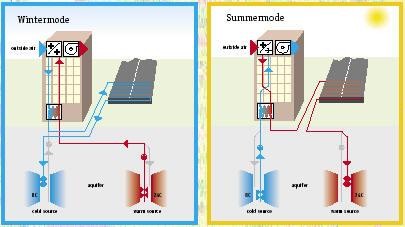Energy from asphalt for heating and cooling buildings and roads
Energy from asphalt
Ooms Avenhorn Holding, Tipspit and WTH Vloerverwarming have jointly
developed Road Energy Systems®, a method for heating and cooling buildings
and roads.
Road Energy Systems® comprises an asphalt concrete layer with a reinforced
structure and a water-bearing medium.
Asphalt concrete’s dark colour has an excellent heat-absorbing property. The
water-bearing medium is able to cool the asphalt in summer (energy
extraction) and heat it during winter (energy addition). The asphalt
collector represents a new way of harnessing solar energy. The longer and
more intensively solar energy is used, the more important it becomes as an
environmentally friendly way of meeting our energy needs. In recent years it
has become increasingly evident that the fossil fuels used to generate
energy are not inexhaustible and that their use is harmful to the
environment (greenhouse effect).
The aim of Road Energy Systems® is to achieve energy savings by using
thermal energy stored in aquifers for cooling and/or heating in commercial
and industrial buildings, industry, residential constructions, earthworks,
civil and hydraulic engineering and the agricultural sector.

Storing energy in the ground
Storing energy in the ground is an energy-saving, environmentally friendly
heating and cooling technique. In summer, Road Energy Systems® generates
considerable heat. This heat is stored in the ground and can be pumped up
for heating purposes in winter. Conversely, the stored winter cold can be
used for cooling in summer. The warm and cold water are seperately stored in
an underground water-bearing sandy layer (an aquifer). The hot and cold
groundwater can be pumped up from the aquifer or it can be injected back.
The vertical conveyor pipelines running from the hot and cold source are
located approximately one hundred metres apart and can be as much as one
hundred metres deep. In winter, groundwater is pumped up from the heat
source. After it has been used for heating, by allowing it through the
asphalt collector, it is injected into the cold source. In summer the
process works in the opposite direction, with water being pumped up from the
cold source and used for cooling. The heated water is then once again led
through the asphalt collector, where it is further heated by the sun and
then injected into the heat source in the ground. This system saves
considerable primary energy (natural gas) as less cooling and heating is
required by the central heating and cooling systems.
The combined use of this storage system with heat pumps and floor and wall
heating requires the control systems to be thoroughly tuned to match the
actual requirement.
Improved traffic safety
In winter the temperature of asphalt can be kept above freezing,
preventing the formation of ice on the road. The evaporation rate of rain
and meltwater is also speeded up. In summer, cooling the surface to below
the temperature at which bitumen begins to soften prevents the asphalt
structures from being deformed. This in turn prevents the formation of ruts
or permanent deformation, which significantly improves traffic safety,
especially under poor weather conditions.
The combination of a reinforced asphalt structure with a heating system
ensures that the road surface will develop fewer cracks in winter. An
asphalt construction incorporating Road Energy Systems® has a longer life
than traditional constructions. This means less road maintenance, resulting
in fewer road closures and traffic jams and hence improved traffic safety
mobility.
Reducing the use of salt
Using Road Energy Systems® to heat roads in winter results in savings on the
use of salt on icy roads, thus lowering the environmental impact of salt.
Reduction in CO2 emissions
Using Road Energy Systems® to heat buildings means using less fossil fuel,
which reduces CO2 emissions.
Environmental gain
Reduction in CO2 emissions
Using Road Energy Systems® to heat buildings means using less fossil fuel,
which reduces CO2 emissions.
Reducing the use of salt
Using Road Energy Systems® to heat roads in winter results in savings on the
use of salt on icy roads, thus lowering the environmental impact of salt.
Ooms AvenhornHolding bv
P.O. Box 1 1633 ZG Avenhorn The Netherlands
Phone +31 229 547700 Fax +31 229 547701
Internet www.ooms.nl E-mail info@ooms.nl
This page originally published at: http://www.roadenergysystems.nl/